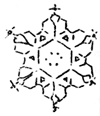|
DEPARTMENT OF INTERIOR
NATIONAL PARK SERVICE
CRATER LAKE NATIONAL PARK
OREGON
Mr. E. C. Solinsky
Superintendent |
Mr. D. S. Libbey
Park Naturalist
Editor |
|
April, 1933 |
Vol. VI, No. 1 |
This publication is issued for the purpose of recording observations
and making known the results of research and scientific investigation
concerning the natural history of Crater Lake National Park. It is
under the jurisdiction of the Research and Education Staff and is
supplemental to the lectures and field excursions conducted by the
staff. Publications using these notes please give credit to the author
and to Crater Lake National Park Nature Notes.
***************
"Thou who wouldst see the lovely and the wild
Mingled in harmony on Nature's face,
Ascend our mountains. Let thy foot
Fail not with weariness, for on their tops
The beauty and majesty of the earth,
Spread wide beneath, shall make thee to forget
The steep and toilsome way."
-- Bryant
The Crystal Gems Of Crater Lake In Winter
By D. S. Libbey
Would that each of you could spend a time in the silent grandeur of
Crater Lake in the dead of winter. After a heavy, moist snowfall, the
boughs of the conifer trees are garbed in beauty. Crater Lake National
Park, on the crest of the Cascade Range, is located in the realm of snow
flakes, the crystal forms of frozen water. The intricate filigree work
and the myriad forms showing snow sculpture everywhere depict "Gaywas"
(the picturesque Indian name for Crater Lake) in fairyland attire.
Literally, as one sees the snow flakes so abundantly developed at
Crater Lake in winter, he realizes that there is no art comparable to
Nature's art and no beauty that can approach the handiwork of Nature.
As Lowell says in verse so familiar: "Every tree twig is bedecked with
crystals, rimmed inch deep with pearl".

The cover design, as well as the margin of this page, shows
treasures of the snow. Snow flakes are among the most evanescent of all
Nature's creations. They are unique and precious particularly so since
they are fleeting forms and cannot be preserved like other gems.
Examine the sketches and you will discern that the snow flake
crystals are formed with six faces, being of the true hexagonal system.
Of course, all snow flakes are not perfect crystals and all gradations
between shapeless amorphous masses to the intricate hexagonal filigree
designs are found. No two snow flake crystals are exact duplicates. If
one is interested in studying crystal forms and is prepared to make
micro-photographs of these fleeting crystals, one has in every new
photographic reproduction a thrill, for each may possess more beauty and
complexity than the previous.

The avocation of collecting reproductions of snow flake crystal
forms has a practical side as well as a pleasurable one which is
vicarious in its nature. Artists, designers, architects and interior
decorators frequently draw from snow crystal designs the foundation for
the creation of bizarre and unique sketches and reproductions. One who
collects such photographs does not find that every snow storm produces
perfect, beautiful specimens.
It appears that ideal conditions for crystal growth are dependent
upon a very fine adjustment of correct temperature, air currents, and
rate of formation. The wind conditions in the sky cause the forming
snow to be driven and forced against other fleecy particles, the
delicate forms are destroyed. The arrangement of the freezing water
molecules and the crowding against one another cause lack of symmetry in
crystal formation. There is little doubt but that Crater Lake National
Park is an area affording an ideal place to study and see the
development of snow forms and crystal aggregates.
"The beautiful is as useful as the useful"
-- Victor Hugo
| 
